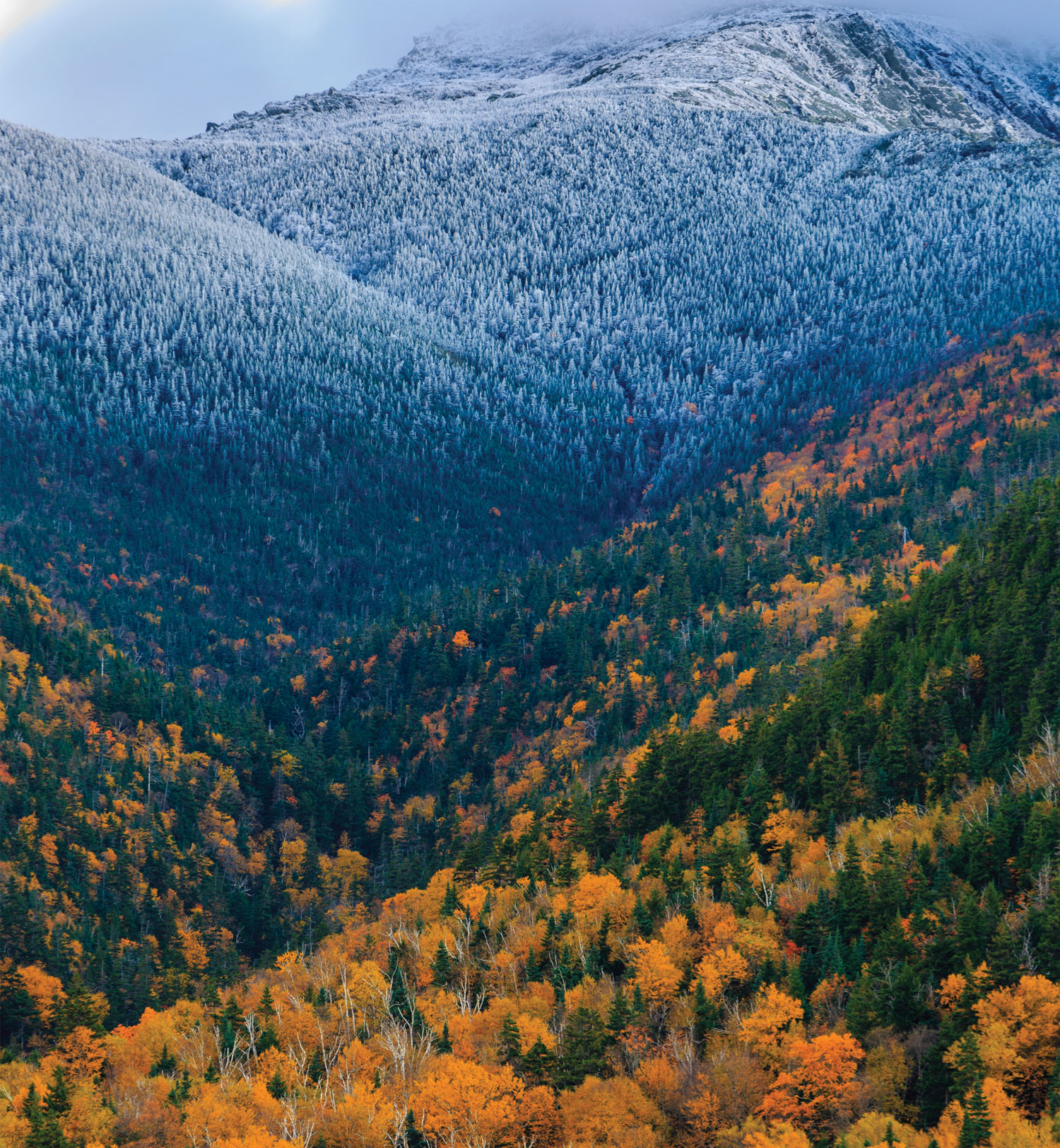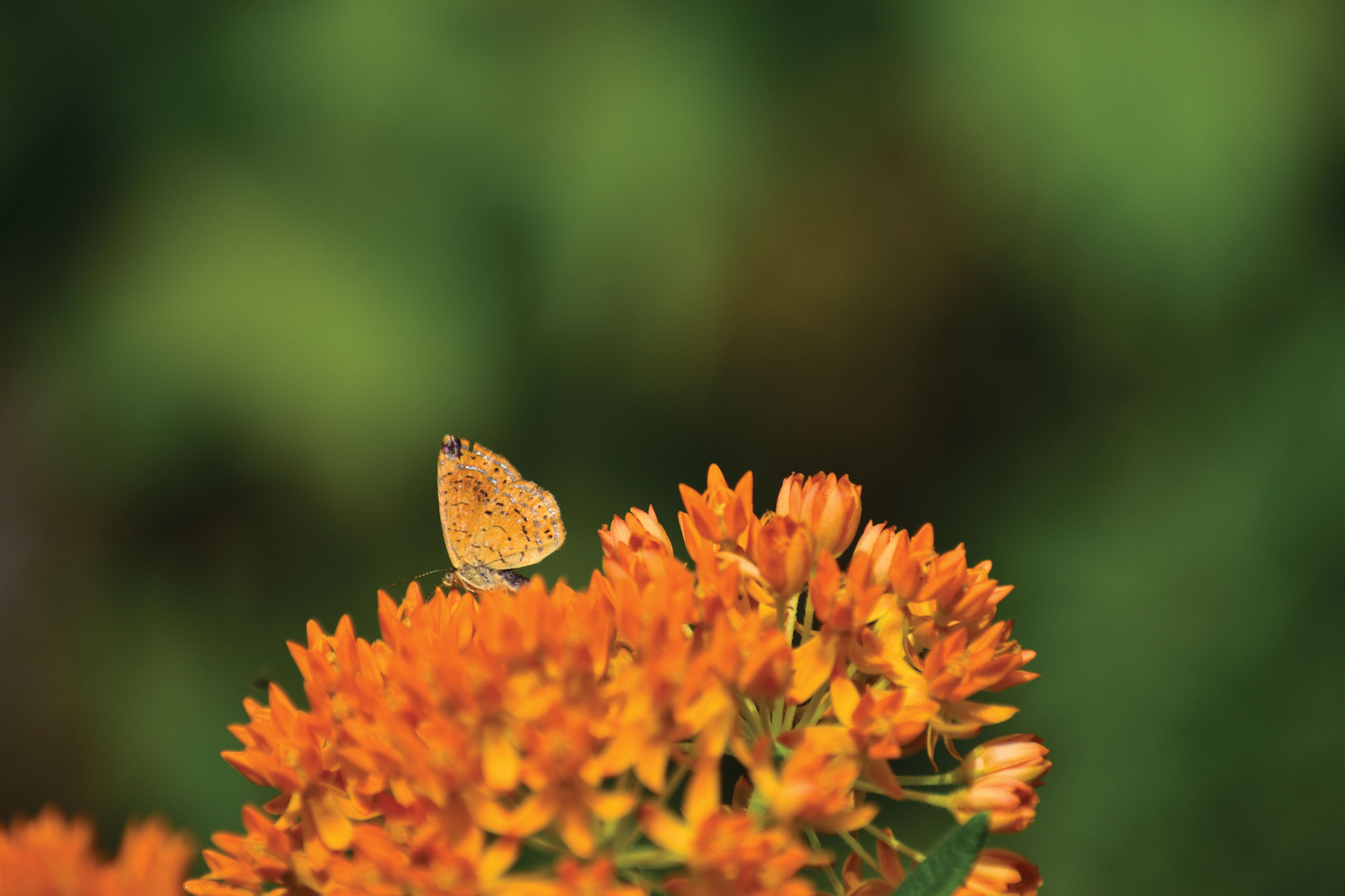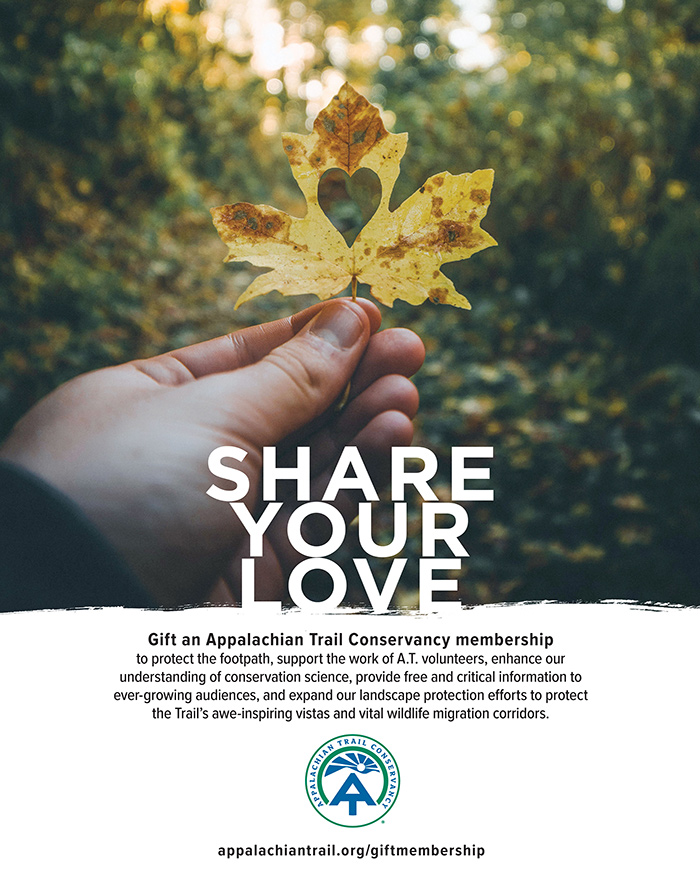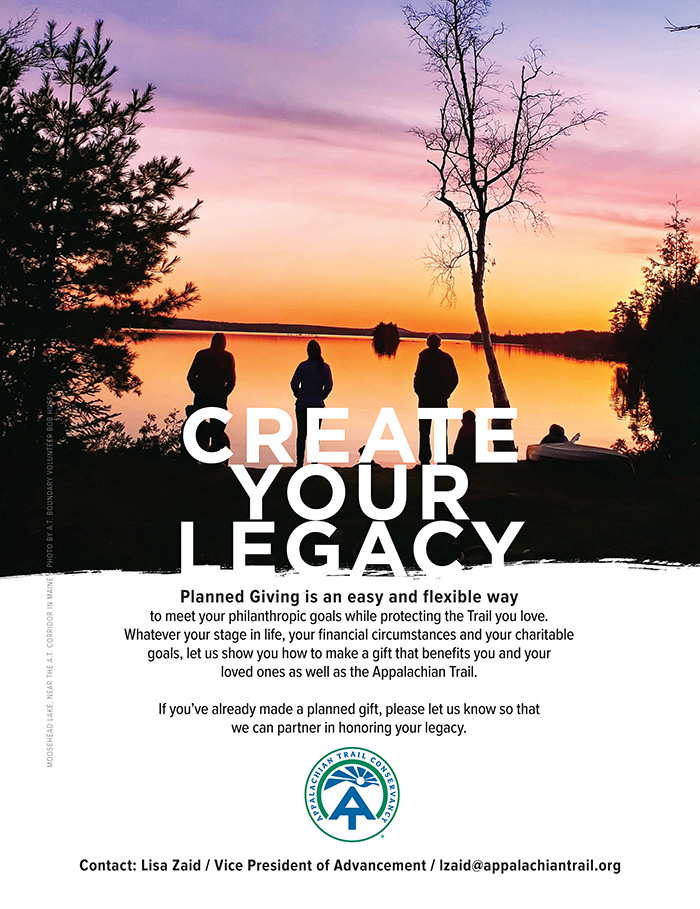Photo by Fern Crossway
A view of fall foliage on Mount Madison from Dome Rock – White Mountain National Forest, New Hampshire. The entire protected A.T. landscape nurtures the most important region of biodiversity and climate resiliency in eastern North America.
Photo by Jerry Monkman
Photo by Fern Crossway
A view of fall foliage on Mount Madison from Dome Rock – White Mountain National Forest, New Hampshire. The entire protected A.T. landscape nurtures the most important region of biodiversity and climate resiliency in eastern North America.
Photo by Jerry Monkman

ATC Executive Leadership
Sandra Marra / President & CEO
Nicole Prorock / Chief Financial Officer
Laura Belleville / Vice President of Conservation and Policy
Hawk Metheny / Vice President of Regional and Trail Operations
Lisa Zaid / Vice President of Advancement
A.T. Journeys
Wendy K. Probst / Editor in Chief
Traci Anfuso-Young / Art Director / Designer
Contributors
Anne Merrill / Associate Vice President of Advancement
Jordan Bowman / Director of Communications
Brittany Jennings / Proofreader
A.T. Journeys is published on matte paper manufactured by Sappi North America mills and distributors that follow responsible forestry practices. It is printed with Soy Seal certified ink in the U.S.A. by Sheridan NH in Hanover, New Hampshire.
A.T. Journeys ( ISSN 1556-2751) is published by the Appalachian Trail Conservancy, 799 Washington Street, Harpers Ferry, WV 25425, (304) 535-6331. Bulk-rate postage paid at Harpers Ferry, West Virginia, and other offices. Postmaster: Send change-of-address Form 3575 to A.T. Journeys, P.O. Box 807, Harpers Ferry, WV 25425.
MISSION
The Appalachian Trail Conservancy’s mission is to protect, manage, and advocate for the Appalachian National Scenic Trail.
Board of Directors
Colin P. Beasley / Chair
Robert E. Hutchinson, Jr. / Vice Chair
James LaTorre / Secretary
Patricia Shannon / Treasurer
Daniel A. Howe / Chair, Stewardship Council
Sandra Marra / President & CEO
Grant L. Davies
Thomas Gregg
Rita Hennessy
John W. Knapp, Jr.
Yong Lee
Colleen Peterson
Eboni Preston
Nathan G. Rogers
Katherine Ross
Rajinder Singh
Jeri Ward
Nicole Wooten
PRESIDENT’S LEADERSHIP CIRCLE
The Hon. Stephanie Martz / Chair
Diana Christopulos
Jim Fetig
Lisa Koteen Gerchick
R. Michael Leonard
Robert Rich
The Hon. C. Stewart Verdery, Jr.
A.T. Journeys is published on matte paper manufactured by Sappi North America mills and distributors that follow responsible forestry practices. It is printed with Soy Seal certified ink in the U.S.A. by Sheridan NH in Hanover, New Hampshire.
A.T. Journeys ( ISSN 1556-2751) is published by the Appalachian Trail Conservancy, 799 Washington Street, Harpers Ferry, WV 25425, (304) 535-6331. Bulk-rate postage paid at Harpers Ferry, West Virginia, and other offices. Postmaster: Send change-of-address Form 3575 to A.T. Journeys, P.O. Box 807, Harpers Ferry, WV 25425.

Photo by A.T. boundary volunteer Jim Williams
Perhaps from the beginning of our existence, humans have been fascinated by fall leaves. We drive to Shenandoah, the Blue Ridge Parkway, the White Mountains of New Hampshire. We travel the globe in search of fleeting colors, paper-like formations, with unique veiny patterns falling from the sky and blanketing the ground with their layers of softness. Stepping upon these fallen leaves, the gentle percussive sounds of fall remind us that what grows from the ground eventually returns there.
But for a few fleeting moments, leaves float from the sky with a kind of cadence and slowness we rarely experience in our daily lives — the world in slow motion. Nature’s confetti. There is something deeply beautiful about watching an individual leaf drift through our shared atmosphere and down to our feet.

As the author of the 2022 book, Halcyon Journey: In Search of the Belted Kingfisher, Marina found an intriguing comparison. “Both butterflies and kingfishers are charismatic megafauna that guide us to wondrous communities of life we might not have noticed otherwise.” Threading natural history, memoir, and mythology, Marina’s book is the first to feature the belted kingfisher, a bird found throughout North America, including the waterways of the Appalachian Trail.
A regular contributor to A.T. Journeys, her stories and essays often reflect a theme of kinship with nature leading to advocacy for protecting wildlife and wildlands. She writes from Bend, Oregon, and values her returns to the A.T. with her late father, Dave Richie’s Trail journals in hand.

“It’s a privilege and a pleasure to see these places and the good work that the ATC is doing to protect them,” he says. Chris enjoys taking home these stories to share with his wife, Sunshine (who thru-hiked the A.T. in ‘04 and ‘05), and his two young children back in Black Mountain, North Carolina. Chris and Sunshine co-created the documentary film: The Long Start to the Journey, which takes viewers along for the adventure, highs, and lows of his A.T. thru-hike. His film can be found at thelongstarttothejourney.vhx.tv.
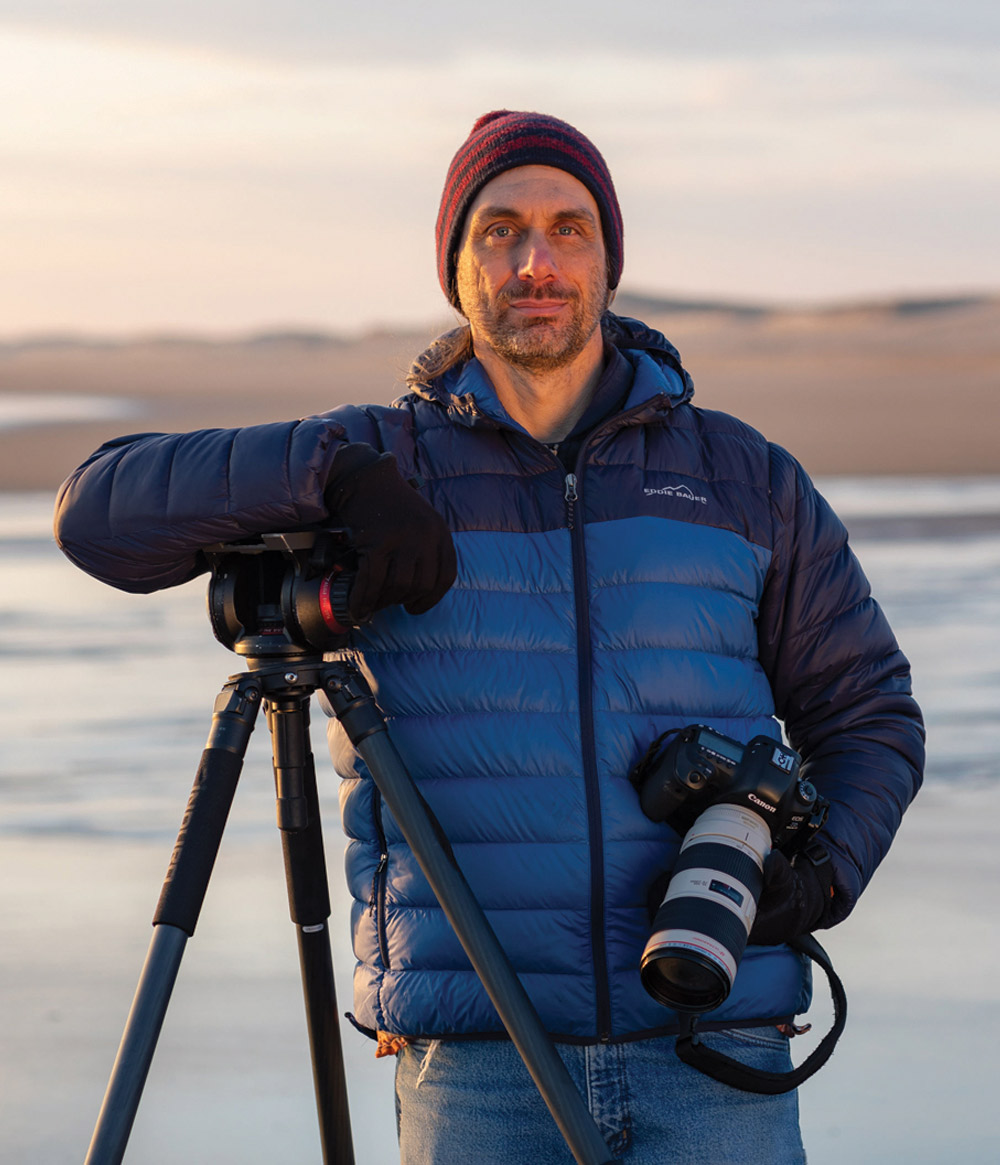
Jerry’s first-ever published photo was on the cover of the July 1993 issue of Appalachian Trailway News and has continued to be featured in A.T. Journeys over the years. “I’ve been hiking on the A.T. for more than thirty years,” he says. “As a conservation photographer, I’ve been involved in projects along or adjacent to the A.T. in the New England area, which have strengthened my belief that conserved open space is important, not only for wildlife and biodiversity, but for strengthening individuals and communities.”

She is the author of three books: Legacy on the Land: A Black Couple Discovers Our National Inheritance and Tells Why Every American Should Care; Our True Nature: Finding a Zest for Life in the National Park System; and From My Jamaican Gully to the World. “My mission is to demystify the environmental sector through sharing my life experience and inspire others to live joyfully while making a positive difference in our world,” she says.
Audrey’s daily social media posts and twice-weekly blog, The Joy Train, extol the benefits of nature in efforts to create “a pandemic of joy.” She co-founded the Diverse Environmental Leaders Speakers Bureau in 2014. Last April, the National Parks Conservation Association presented her with the 2022 Centennial Leadership Award, saluting her twenty-five years of dedicated effort.
highlights / events
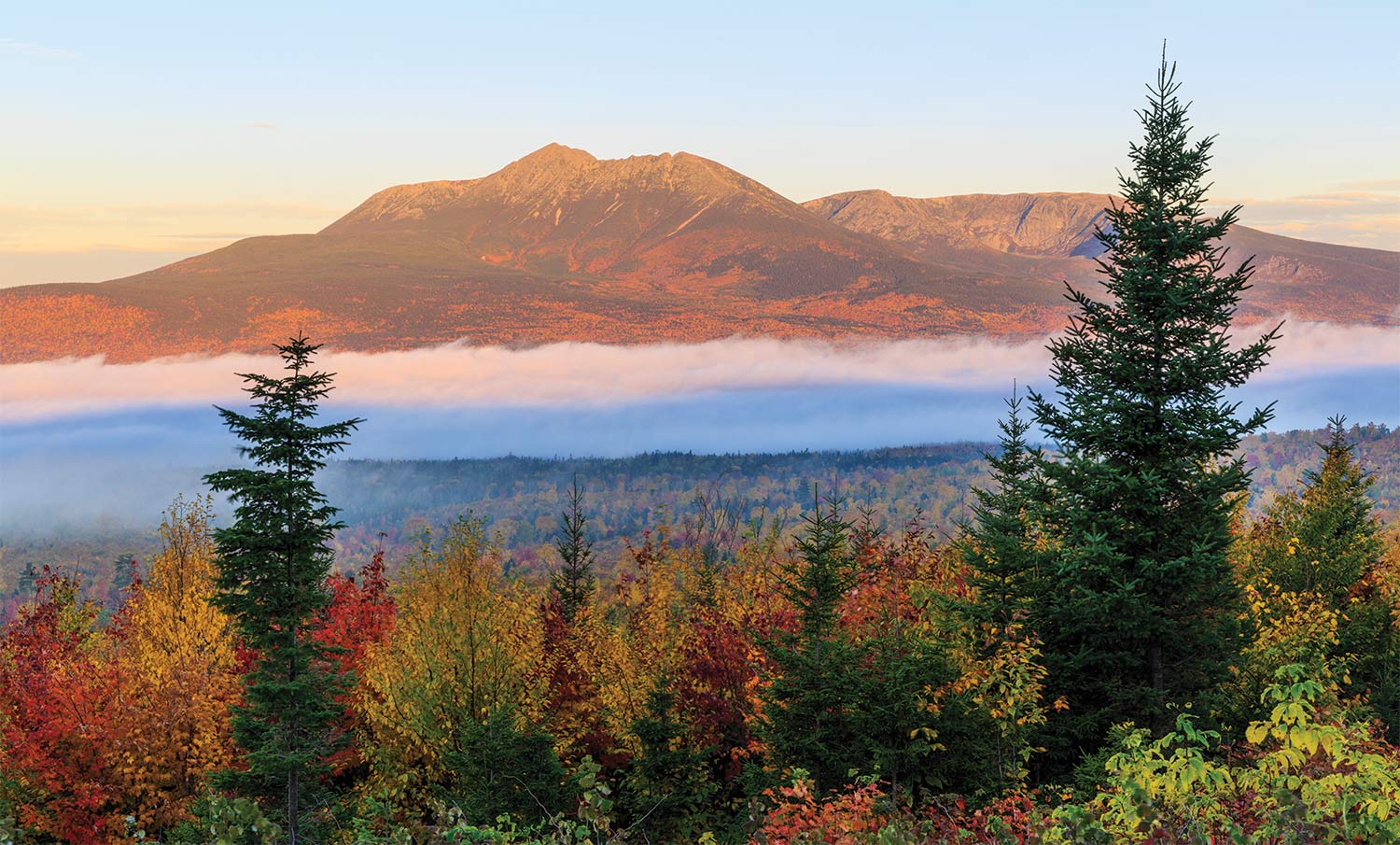
Rita Hennessy began hiking the A.T. as a teenager in Connecticut and later served as an A.T. ridgerunner. She held a thirty-year career with the National Park Service, where she served as recreation specialist and then assistant superintendent of the Appalachian National Scenic Trail Park Office for eighteen years. She completed her career as the National Park Service Program lead of the National Trails System and Wild and Scenic Rivers.
Yong Lee’s decades-long career in management has spanned both non-profit and for-profit sectors. She served as the chief of staff to the Secretary of the Smithsonian Institution in Washington, D.C. She previously served as the chief of staff to the President of Morehouse College, a historically Black college for men in Atlanta, Georgia. Yong has hiked portions of the A.T. in Virginia, Maryland, West Virginia, Pennsylvania, New York, and Maine. She is an avid backpacker, mountaineer, and rock climber.
Katherine Ross is the retired President of Johnson & Johnson (J&J) Health Care Systems. She has more than thirty-five years of operating experience and has led supply chains (and lived) in Asia, Europe, and the United States. Her most recent role was leading J&J’s global logistics and customer service operations, managing a $2 billion spend across seventy countries. Katherine has hiked portions of the A.T. throughout her life and in 2022 embarked on a southbound section hike from Harpers Ferry, West Virginia.
John Knapp grew up hiking and paddling in the Blue Ridge Mountains and Shenandoah Valley in Virginia and has been section hiking the A.T. since earning his Boy Scout Fifty-Miler patch many years ago. He retired from a career at Verizon in 2012 and then worked as state director for U.S. Senator Tim Kaine during his first term. He also served twenty-four years in the Army National Guard, retiring as a Lieutenant Colonel. (See John’s “Parting Thought”).
Patricia Shannon is currently the chief financial and operational officer for the AARP Foundation, based in Washington, DC. She enjoys exploring the great outdoors and has most recently been hiking the trails of Shenandoah National Park and southwest Virginia. She has extensive for-profit and nonprofit management experience. Patricia is a CPA and a Chartered Global Management Accountant.
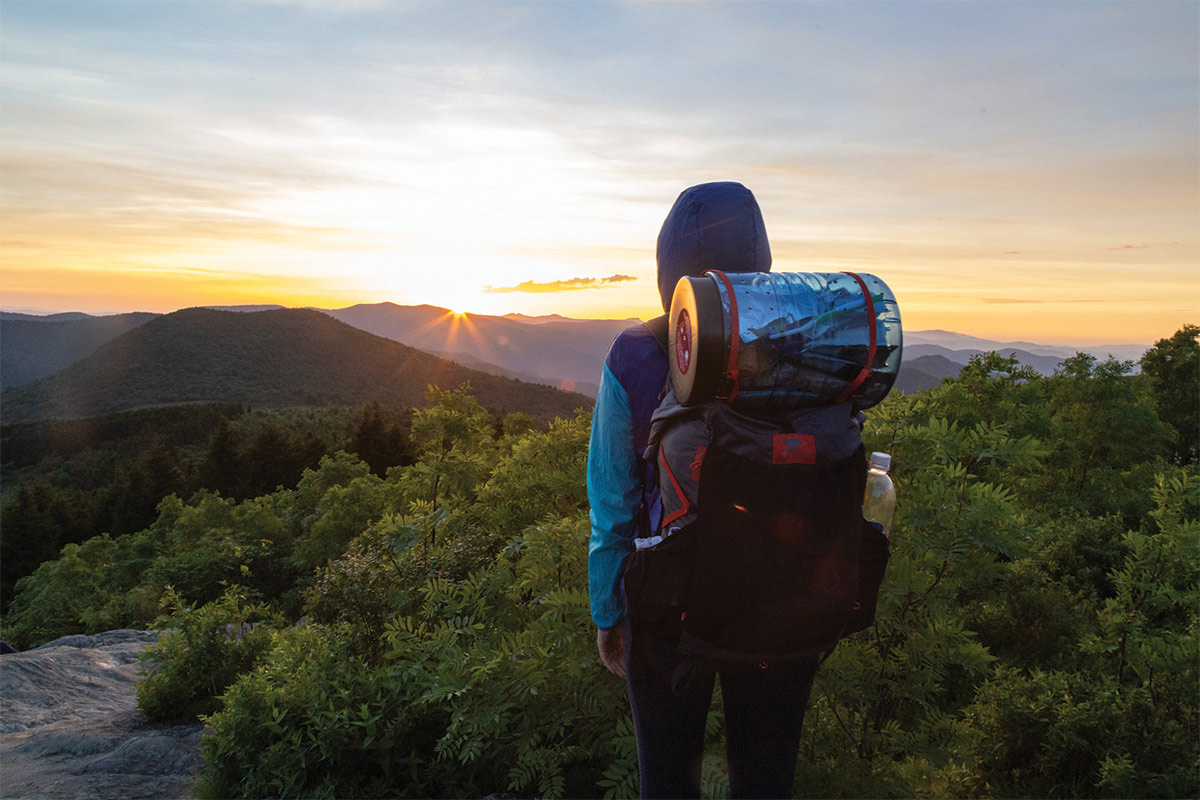
“Black bears along multiple sections of the Appalachian Trail have become increasingly adept at defeating traditional food hangs, where a hiker stores their food over a tree branch using a rope and storage bag,” says Hawk Metheny, ATC vice president of Regional and Trail Operations. “This is even when food hangs are done completely right, and sometimes that just isn’t possible depending on where you are camping.”
By using bear-resistant containers, hikers can help prevent more bears from becoming habituated to humans as a source of food, as well as minimize their chances of a negative bear encounter. The ATC promotes the use of food storage containers approved by the Interagency Grizzly Bear Committee, which have a high success rate in preventing all species of bears from easily accessing hiker food supplies.
To help educate Trail visitors about the benefits of bear-resistant containers, the ATC is encouraging the development of container rental or loaner programs in addition to those already in place in Georgia and Vermont. “Loaner programs like these will help introduce a new generation of A.T. hikers to the benefits of bear canisters, not the least of which is overall increased convenience and ease of use,” says Metheny.
The new ATC food storage policy was developed in coordination with multiple A.T. land management agencies, including the National Park Service and the U.S. Forest Service.
For more information visit appalachiantrail.org/foodstoragepolicy.
To view the list of approved food storage containers, visit igbconline.org/programs/bear-resistant-products
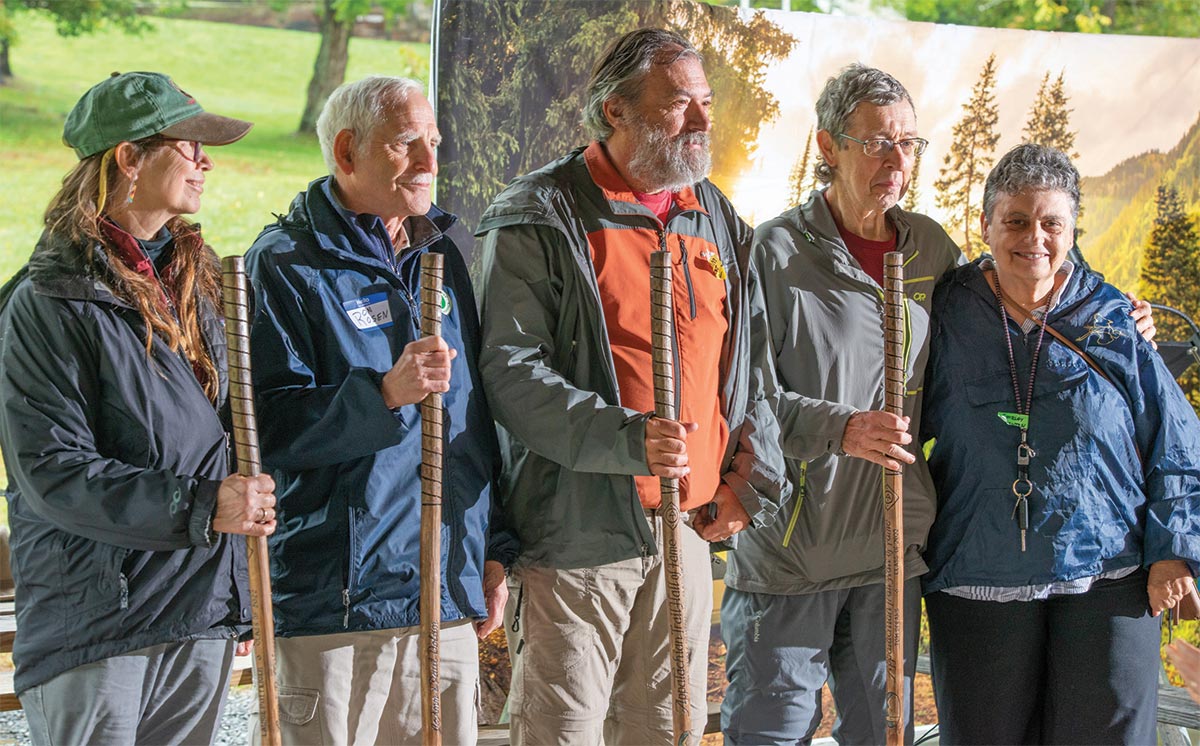
The Honorees were the late Jim and Molly Denton of Front Royal, Virginia; JoAnn and Paul Dolan of New York, New York; Laurie Potteiger of Harpers Ferry, West Virginia; and Tom Speaks of Cleveland, Tennessee.
The Dentons were primarily responsible for the longest contiguous reroute in the history of the Trail, which moved the A.T. from a rapidly urbanizing area in southern Virginia to a more protected area within the Jefferson National Forest along the Virginia-West Virginia border.
The Dolans spearheaded the effort to save a forested area north of New York City, through which the A.T. passes, from development and form the 22,000-acre Sterling Forest State Park.
After her 1987 A.T. thru-hike, Laurie Potteiger began her 33-year career with the ATC. Over the decades, Laurie assisted and inspired thousands of visitors, including countless thru-hikers, at the ATC Headquarters and Visitor Center in Harpers Ferry. She also helped found the annual Flip-Flop Festival, which encourages long-distance hikers to begin their journeys at various places along the Trail rather than adding to the annual influx of hikers in Georgia, reducing the negative impact on Trail resources.
Tom Speaks played an important leadership role for the U.S. Forest Service in achieving critical land acquisitions in the South. He led a Forest Service team responsible for A.T. acquisitions from Georgia to central Virginia., including Rocky Fork, Spy Rock, Max Patch and the Roan Highlands.
Each Hall of Fame honoree or representative received a hiking stick, custom carved by John “Bodacious” Beaudet. The ceremony also featured a talk by Trail legend and 2020 Hall of Fame inductee Warren Doyle (a multiple-A.T. thru-hiker and creator and director of the Appalachian Trail Institute), the grand opening of the A.T. Museum’s interactive Trail display, an interview with new inductee Laurie Potteiger and guided tours of the Museum and the Ironmasters Mansion.
For more information about the inductees and the A.T. Museum visit atmuseum.org.
ecophotography.com
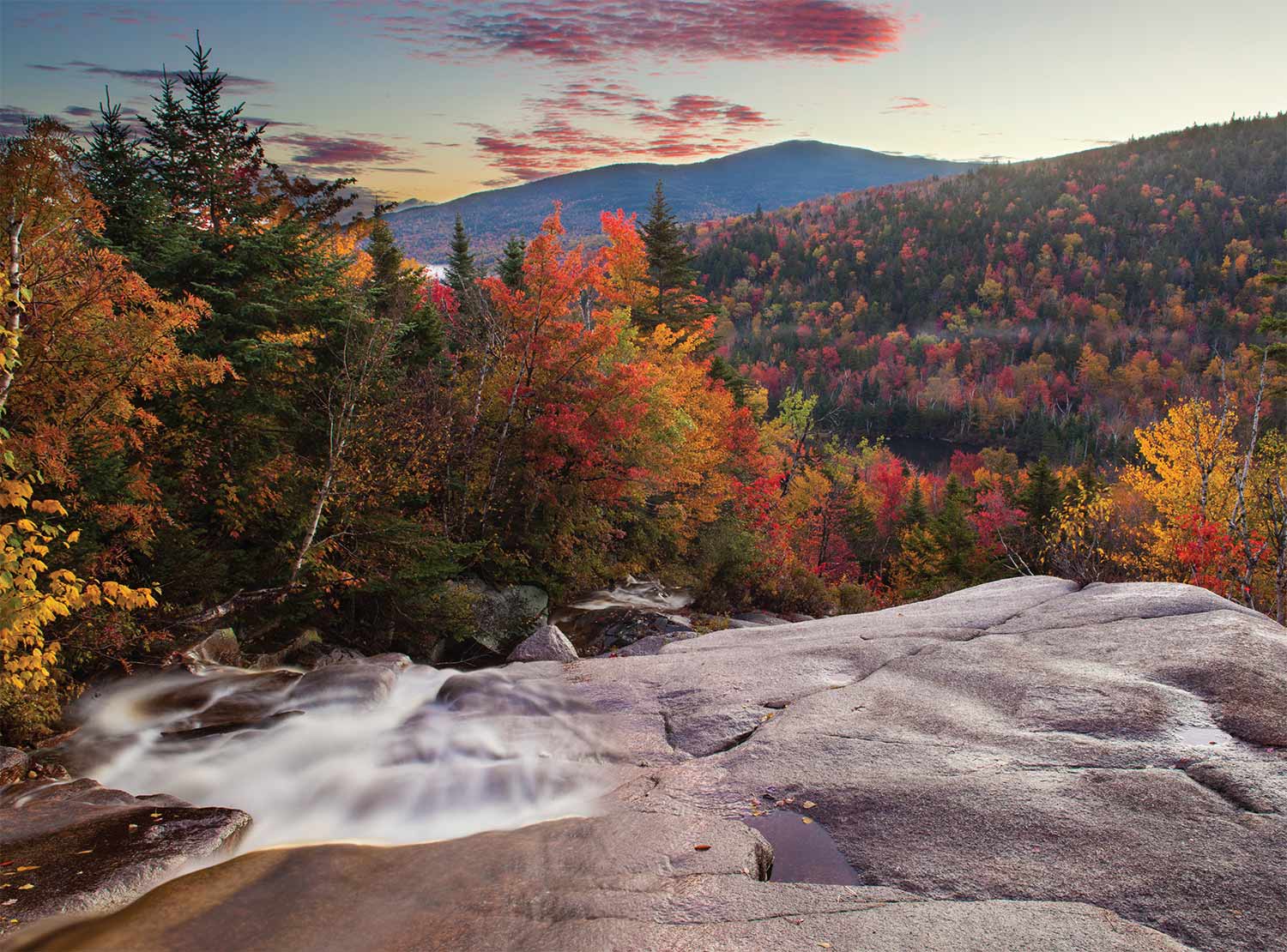
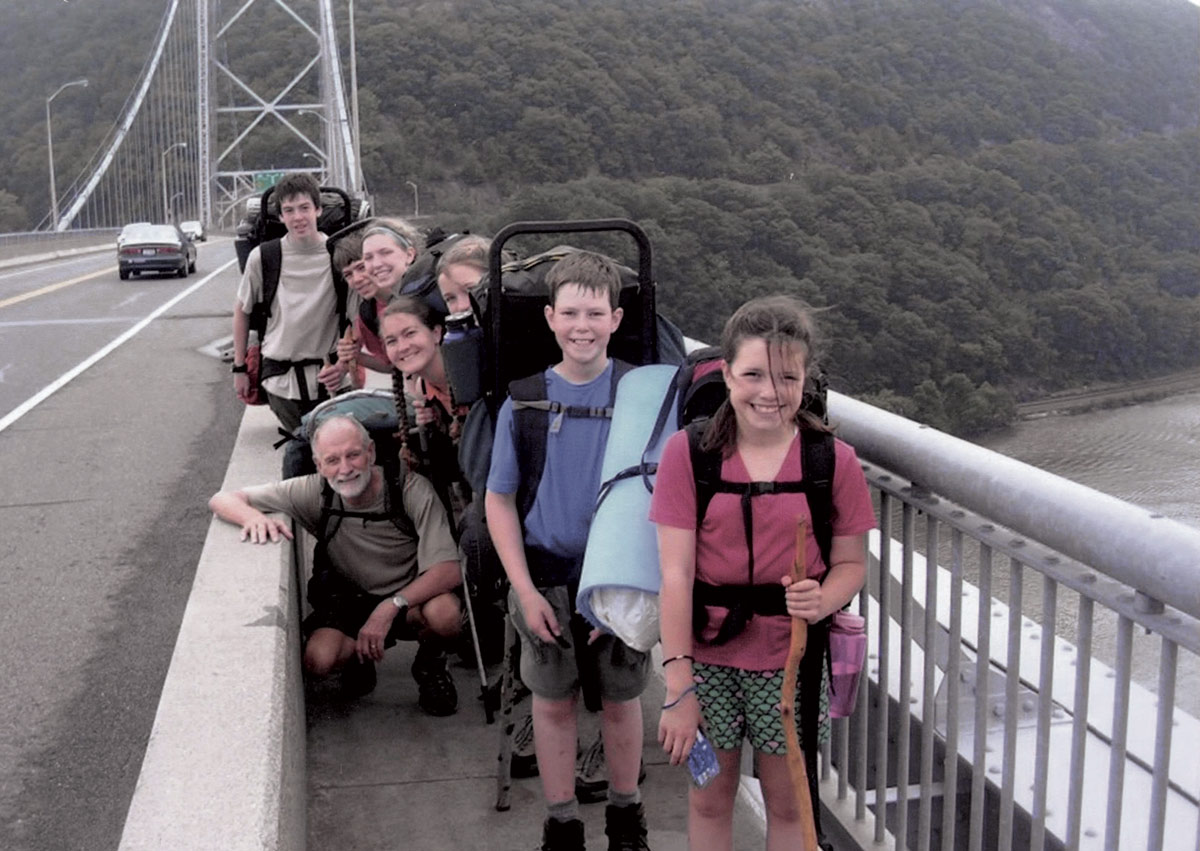
In passing on his love of the A.T. to the next generation, Larry is upholding a time-honored tradition.
FROM GENERATION
TO GENERATION
The journey typically transpired something like this: Two minivans packed with seven middle-schoolers, three or four adults, and their gear depart Holland, Michigan. They drive some 700 miles to a pre-selected section of the Appalachian Trail. Upon nearing the destination, the vans diverge and travel to two trailheads roughly forty miles apart. Then, two groups begin a four-day trek along the Trail, walking towards each other until they meet somewhere in the middle. They spend a night together at the same campsite, sharing stories of their adventures and vying for the chance to talk. The next morning, the adults swap car keys and each group proceeds to the other group’s minivan. Eventually they all meet up at a motel on the drive back to Michigan — where pizza and pool time are prerequisites.
That path? The butterfly leads and biologists follow. The resulting habitat restoration is finely tuned over time. Appalachian Trail Conservancy (ATC) staff and partners have pulled invasive barberry and bittersweet, planted nectar wildflowers, and felled single trees to create sunny glades within the hardwood forest canopy. Each tweak to remove a threat or enhance metalmark habitat results from what the butterflies teach the scientists.
At first glance, a northern metalmark appears the opposite of a monarch reigning over wildflowers in a royal cloak of orange wings etched in black. Where the monarch is a long-distance migratory champion, the demure metalmark is a stay-at-home specialist few people will ever see. Monarchs face dangers from Canada to Mexico; a whole colony of metalmarks can be eliminated in one fell blow (as happened in Connecticut at a rock quarry). However, the two butterflies share striking qualities as pollinators reliant on one kind of caterpillar host plant. For the monarch, it’s milkweed. For the northern metalmark, the host is roundleaf ragwort. Both butterflies are at high risk of vanishing forever unless people care enough to take meaningful actions based on science — not just once, but over the long run.

These are just a few of the most common questions asked by people who come through the doors of the newest Appalachian Trail Conservancy (ATC) visitor center — located in the heart of Damascus, Virginia. Visitors hail from as close by as across the nearby Tennessee state line and from as far away as Alaska, Brazil, Germany, and Sweden. In total, more than 1,700 people visited the center in its first six weeks after opening on August 27, 2022.

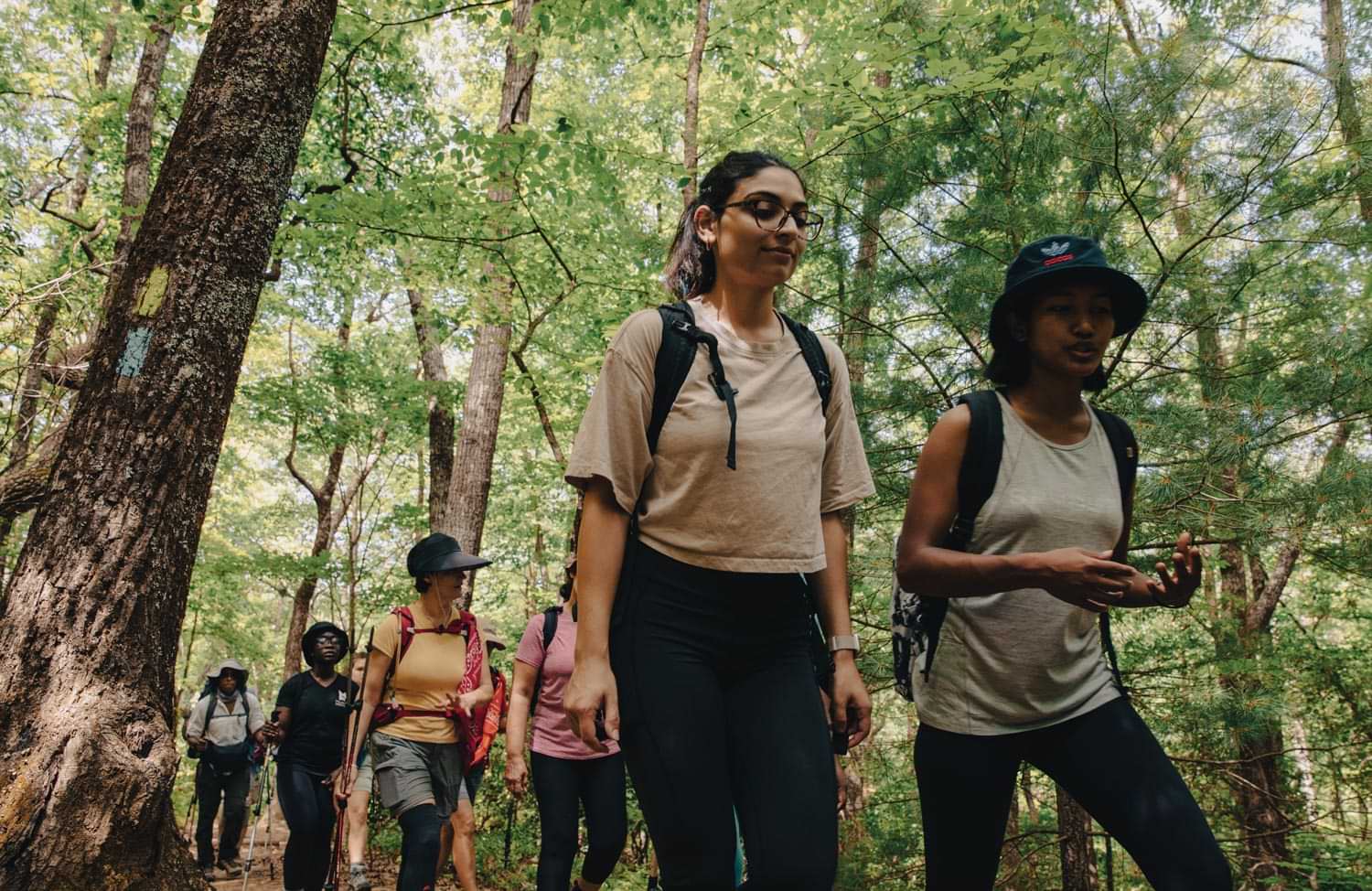

MacKaye did not envision a trail serving the desires of a privileged few, but rather the needs of the average person. From its inception, therefore, the Appalachian Trail was intended to be a welcoming place for all — regardless of ability, experience, or various other factors.
Fulfilling this vision of inclusiveness in the early decades of the 21st century remains a challenge. And yet, there are countless stories of people who experience on the Trail something akin to what MacKaye intended: a sense of peace, rejuvenation, and communion with nature and one another. One such story took place last summer in northwest Georgia.
Inspired
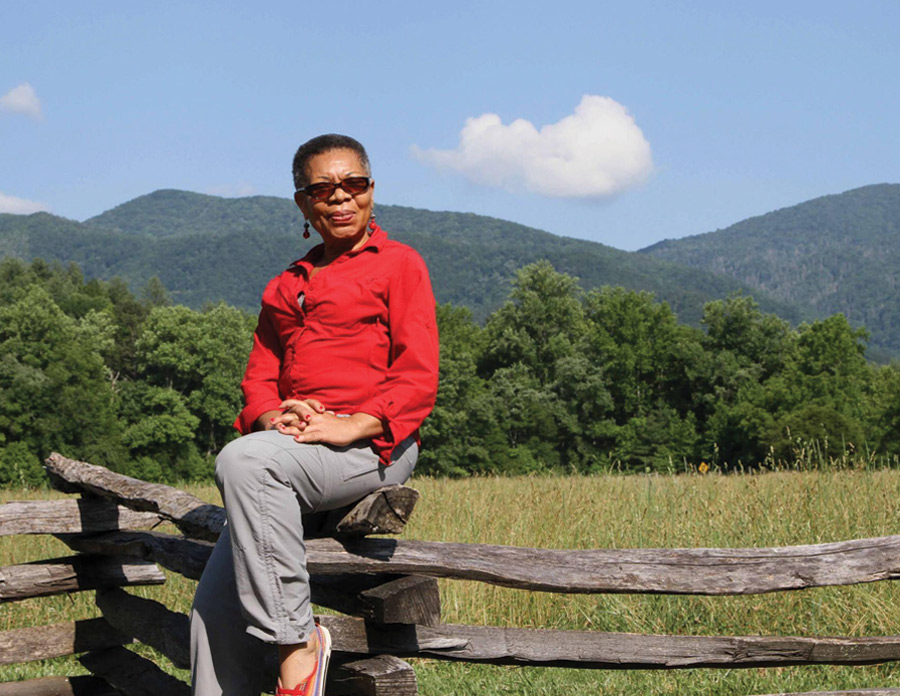
What inspired human rights and environmental justice advocate Audri Scott-Williams to walk across every continent except Antarctica to promote peace?
The Appalachian Trail.
What excited health, wellness, and aging coach Carolyn Hartfield so much that after her first-ever hike at fifty-six years old, she formed a hiking group and has led thousands of people on hikes across the U.S. and multiple other countries?
The Appalachian Trail.
What empowered long-distance hiker and outdoor diversity champion Daniel “the Blackalachian” White to decide to live off the grid and devote his life to educating the public about how to live more sustainably?
The Appalachian Trail.
What made local, state, and national park advocates/supporters Tanya and Larry Pender decide to form “Pathways to Parks” and attract Black and Brown Americans to the A.T. and other trails?
$500,000 and above
Estate of Edward Sohl
Leader
$100,000 to $499,999
Mr. Robert Lodato
Partner
$50,000 to $99,999
Mr. Sam Ferguson
Mr. Philip Rosenkranz
Estate of Edward Snyder
Advocate
$25,000 to $49,999
Anonymous
Daniel and Laura Gold
Estate of William and Lorraine Hanaway
Estate of Barry Katz
Rubén and Valerie Rosales*
Ms. Ann Satterthwaite
$10,000 to $24,999
Anonymous
Grant Davies*
Norman and Adrienne Findley
Estate of Jim Fredlock
Sara and Thomas Gregg*
Steward
$5,000 to $9,999
Mr. Ellis and Nancy Alexander
Marian Baker
Laura and Buzz Belleville#
Joan Bender and Mr. Michael O’Shea
Hunter and Meghan Cloud
Mr. Daniel Collins
Supporter
$1,000 to $4,999
Anonymous (3)
Barbara Abribat
Thomas Abrunzo
Leader
$100,000 to $499,999
Fidelity Charitable Gift Fund
Vanguard Charitable Endowment Program
The Volgenau Foundation
WilmerHale
Maintainer
$25,000 to $49,999
Benevity Community Impact Fund
Devils Backbone
ENO Nation
Fidelity Brokerage Services LLC
Independent Charities of America
National Park Foundation
SAIC, Inc.
Schwab Charitable Fund
Squire Patton Boggs, LLP
University of Virginia Law School Foundation
$10,000 to $24,999
Bank of America Charitable Gift Fund
BearVault
Jan S. Bender Revocable Trust
Brookfield White Pine Hydro LLC
W. L. Lyons Brown Foundation
Charles Schwab
Hiker
$1,000 to $9,999
Anonymous
ACT for Alexandria
Amazon Smile
American Backcountry
American Endowment Foundation
America’s Charities
Ameriprise Financial
Appalachian Long Distance Hikers Association
AXA XL

“Thank you for your service” is a sentiment that I hear — and say — often. Lately, I have been thinking a lot about service. This issue of A.T. Journeys comes to you around Veterans Day, a holiday that is especially meaningful to me. I am writing this, however, in mid-September when two events are dominating the news. This first is the anniversary of 9/11, which annually causes me to reflect on the service and sacrifice of so many people on that awful day. The second is the death of Queen Elizabeth II. She was no doubt a woman of privilege, but one who devoted her whole life to serving the British people. Each of these converging events remind me that there are many ways to serve.
The Appalachian Trail has a long history of being a place of solace, refuge, and healing for veterans. Earl Shaffer leads a long list of veterans who have used the Appalachian Trail to “walk off the war.” While some may proudly show their colors as they hike, there are many others out there just quietly using the Trail. As is so often the case, you may never even know they are veterans. I think there may be no higher purpose for these public lands than to be a resource for those who have served us all.
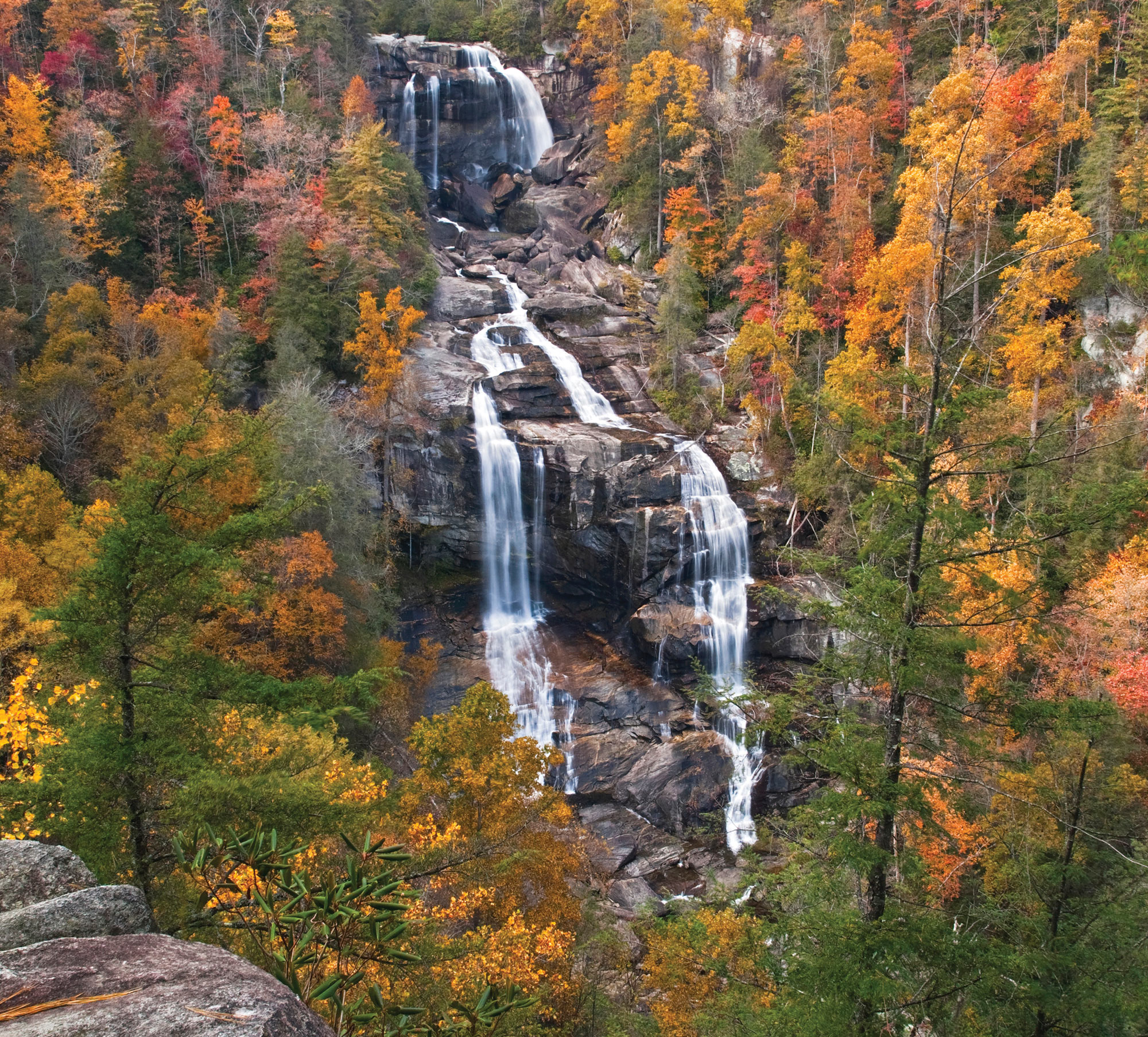
Photo by Jerry Greer

